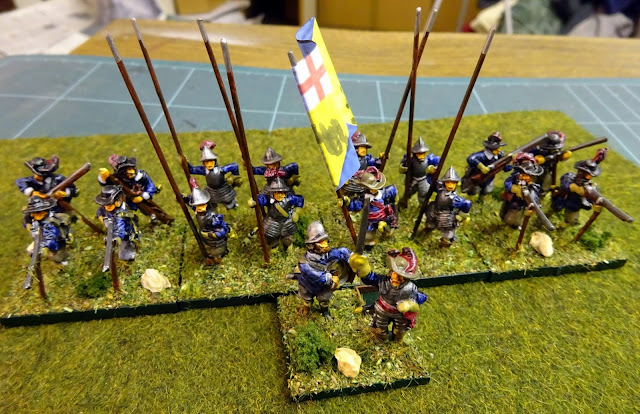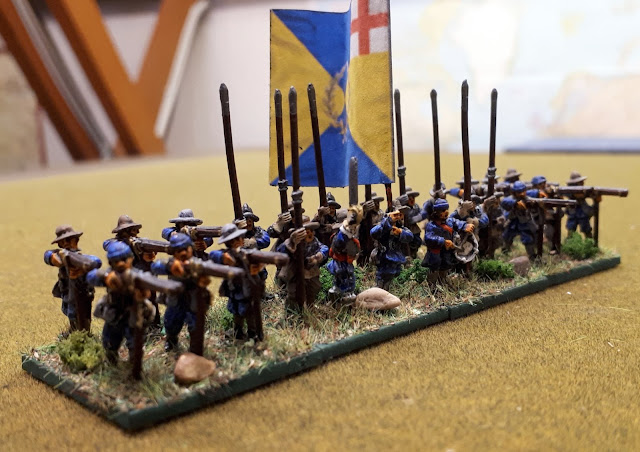I'm just glad to be here, happy to be alive (At the end of the line)
'End of the Line'
Traveling Wilburys
If all goes to plan this will be my 900th post since I started blogging back in February 2007 (it didn't go to plan as a couple of other posts snuck in first so this is actually the 902nd'th), which means I've been blogging for about 12 years, now.. I have to say it's been remarkably good fun - chatted with a whole load of people, had a whole load of kindness'es done (figures given and sent, magazines donated - you know who you are, Jim - advice on a myriad of subjects. etcetc), but as far as I'm concerned the post is BAU, and I now look forward to the next 12 years and what I guess is the next milestone which is the 1000th post...!
Either way, with some time on my hands after I'd completed the American dismounted dragoons, I cast around for something to do and happened to spot out of the corner of my eye the ACW ships I built last year, and which I had not yet played a game.. decision made then!
So for this game a mixed force of three (fictional, but typical) Confederate blockade runners have been intercepted by a (fictional, but typical) Union force consisting of an ironclad monitor, and a small gunship..
 |
| CSS Butternut, and the CSS Tiger |
 |
| CSS Robert E Lee and in the background the USS Drewery |
 |
| USS Monitor |
I was hoping that this would give a fairly balanced game as although the Confederates have a larger number of ships, the monitor should balance the equation...
Objective is for the Confederate ships to exit the opposite table edge.. game was played lengthwise on a 6' x 4' table..
Armaments:
'Robert E Lee' - 2 x Medium rifled guns (fore and aft) and a broadside of 1 Medium and 2 Small Smooth-bores per side - light armour
'Butternut' - 2 x Medium rifled guns (fore and aft) and a broadside of 2 Small Smooth-bores per side - light armour
'Tiger' - 2 x Medium rifled guns (fore and aft) and a broadside of 2 Small Smooth-bores per side - light armour
'Monitor' - 2 x Heavy Smoothbores - heavy armour - also classed as "small" target
'Drewery' - 2 x Medium rifled guns (fore and aft) - light armour - also classed as "small" target
So the "Rebs" have more guns, but the "Bluebelly's" have bigger guns, (some) better armour, and are harder to hit ..

Starting positions as follows:

Game:
Turn 1:
The US win the initiative and both sides get 3 action points to play with..each side advances, with the Confederates turning to starboard so as to get their broadsides in arc...

Turn 2:
The US win initiative again but only get 1 AP. With it, the Monitor opens fire on the Robert E Lee at long range but misses (and this was to be a theme for the whole game!) Drewery being smaller does a double move - I had an idea to use her as a flanking force..
In the Confederate phase the Robert E Lee opens fire on Monitor at long range and hits 3 times (!), though one of these is saved when the test for small target was taken into account - being medium and light guns that also means there is an additional save which meant neither of these shots had penetrated Monitors heavy armour to do any significant damage... elsewhere, Butternut and Tiger fire their main armament at Drewery but miss..
 Turn 3:
Turn 3:
..and the games begins to go decisive..
The Confederates win initiative, and throw 3 AP's.. with them the Robert E Lee again opens fire on Monitor but this time with no effect. Butternut and Tiger again fire their main armament at Drewery and this time cause a hit and start a fire
What it does do is cause the US to spend their AP's on recovering from damage sustained in the Confederate phase - so no shooting, just the obligatory (free) move forward.
Turn 4:
The Confederates win initiative again, and have 2 AP's - they move forward, turn to port (so as tot be heading up the table for their exit edge) and fire everything they have at Monitor.. (five medium rifles, 1 medium smooth-bore and a handful of light smooth-bores - basically everything except the kitchen sink) – causing two hits, one of which penetrates causing 'confusion' on board Monitor
The US throw 4 AP’s which Monitor uses to move and recover from before firing unsuccessfully and reloading. Drewery turns, moves twice and fires (and misses) - yet another turn of poor gunnery by the US.
 Turn 5:
Turn 5:
For the third time the Confederates win initiative, and roll 2 AP's - basically they repeat the actions of the previous turn but without the successes they saw while firing..
The US only get 1 AP which Monitor uses to fire at Tiger, causing two hits neither of which penetrate despite weight of shell. Drewery needs to manoeuvre to avoid running aground so doesn't fire..
 Turn 6:
Turn 6:
Finally the US win back the initiative and also with the maximum of 4 AP's - they have the opportunity to start finally hitting back.. Monitor reloads, fires (and misses!), before manoeuvring (so as not to hit Drewery

), and at the same time reloading…
The Drewery manoeuvres, and fires at short range at Butternut causing two hits (at last!), one of which penetrates causing engine damage and a boiler explosion (permanent reduced speed)..
The Confederates have also got 4 AP’s – with it Butternut recovers the engine failure and then fires back at Drewery causing 1 pt damage before moving.. Tiger and Robert E Lee move twice and fire their broadsides at Monitor (3 hits) - at this point in time the Confederates are simply obeying orders which is to get their ships off the far end of the table rather than inflict what could easily be a crushing defeat on the Union navy..
 |
| Nothing they can do... |
Turn 7:
I called the game as a Confederate victory – all ships will exit the the board as ordered - a little singed round the edges but nothing that couldn't be repaired in the Confederate graving yards up river..
Post match analysis:
- Rules used were a set I picked up via the web from Bill Gilchrist - I won't go into a huge load of detail, as I believe there was a hope/plan they might be picked up by Osprey as a future rules release? What I can say is that I like them lots, as for me they hit that lovely spot between simplicity and complexity ie. just enough of each to give tactical decisions to make, with detailed weaponry, and period flavour, while not drowning in rivet counting...
- Clearly a most unbalanced scenario as what is more important in these rules is weight of shot rather than thickness of armour... bottom line if you have kitchen sinks to throw, even if they are not very big kitchen sinks, then the more kitchen sinks the better as statistically one of them is going to do some damage!

- Rules reviews for "Cruel Sea's" the WW2 patrol boat set from Warlord, have shown an interesting method of showing speed - basically a cone placed underneath the back of the ship and placed so as to show speed- see following - I like it and will manufacture something similar as it is one less thing to have to track - if I can also build in a turn circle it will be two things less to track
...
- Stay tuned as the South will sail again - somehow or another they need to get back down river.. and sure as eggs the Union is not going to allow that!
- This post also prompted me to put together a "project page" - I toyed with the idea of adding it to the current American Civil War one, but for the time being it will live separately.. link to the left under "Projects"



































